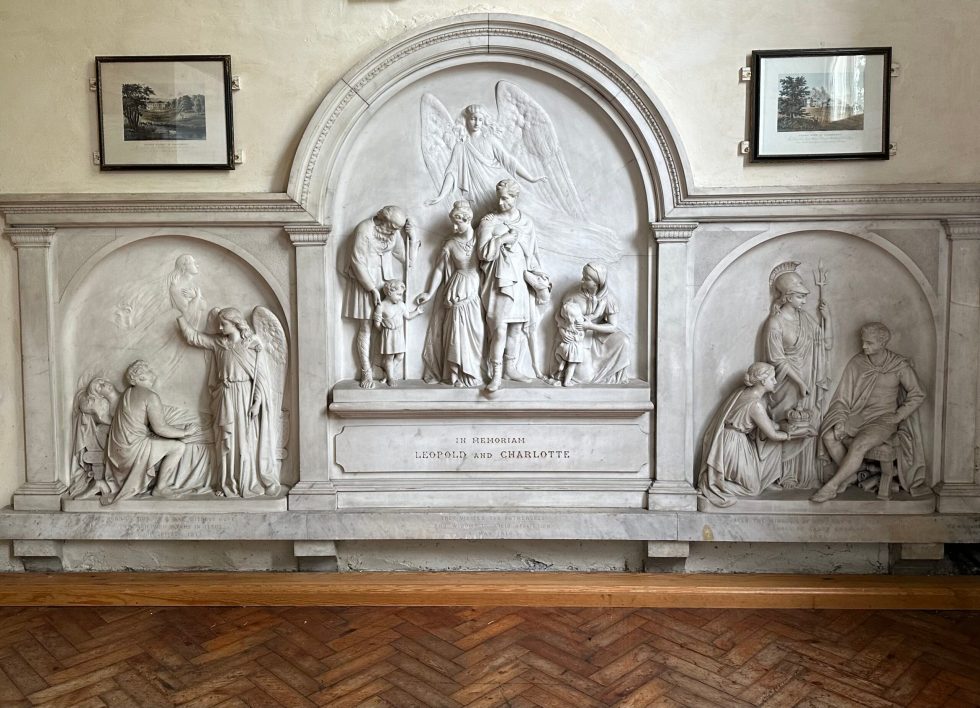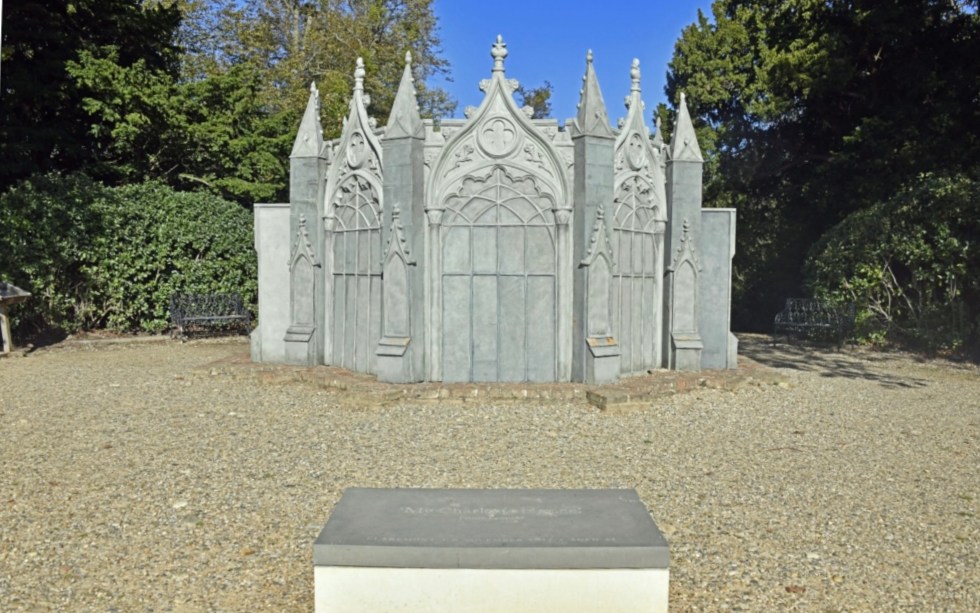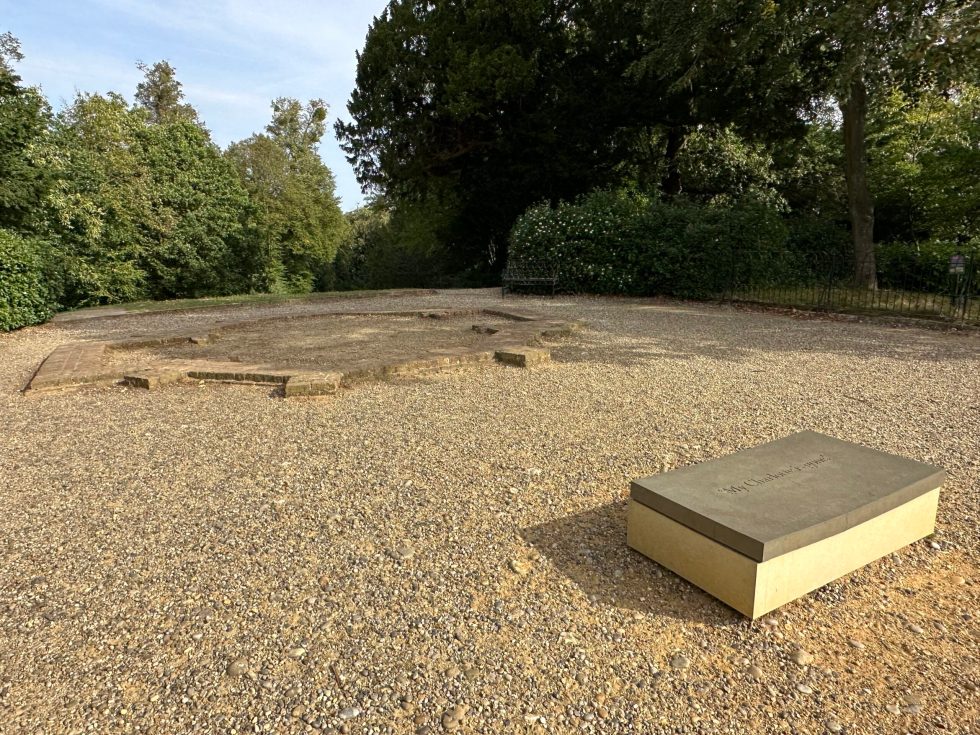Soon after her marriage in 1816 Princess Charlotte of Wales, only daughter of the future George IV and his estranged wife Caroline of Brunswick, settled at Claremont House in Surrey with her husband Prince Leopold of Saxe-Coburg. The Princess ordered the construction of a gothic summerhouse on the spot where she first alighted on the estate, and called the retreat her ‘House on the Hill’. In the spring of 1817 there was great public rejoicing when it became known that the Princess was expecting a child who might one day be king or queen.

The site chosen for the Gothic Temple was on high ground with a view to the lake with its island and temple, and on the slope below the new building was the great turf amphitheatre created by Charles Bridgeman in the 1720s. On the 25th of October 1817 the Princess was taken to view the work at the temple, which was to be her place of ‘retirement in warm weather’. But only a few days later ‘calamity arrived that robbed the nation of its dearest hopes’ – on 5 November Princess Charlotte’s child was stillborn, and the princess herself died the following day.
A distraught Prince Leopold decided to adapt the almost-completed summerhouse as a monument to his late wife. The interior was redesigned to favour more sombre colours, and representations of grief were included in the designs for the painted glass doors. Contemporary reports name the architect as John William Hiort (1772-1861) whose career was championed by Sir William Chambers, but other sources suggest that John Buonarotti Papworth (1775-1847) and Augustus Pugin (1769-1832) also contributed to the design.

In 1818 Prince Leopold granted permission for the public to visit Claremont ‘during his absence on the continent’. The newspapers reported that ‘immense crowds’ descended upon Esher to visit the house and park, where could be found the ‘small and elegant Gothic mausoleum’. The building was incomplete at that date, and the visitors would not yet have seen the painted glass being prepared by the ‘ingenious artist’ Joseph Backler (c.1788-1848). In 1819 the public had a chance to see the designs when Backler displayed the windows in his London gallery. They were then installed in the mausoleum where they cast a ‘chastened mellow light’ on the ornately plastered interior. Before her premature death the princess had sat for the sculptor Federico Nicoli: the portrait bust was completed posthumously and placed on an altar in the mausoleum (although by 1844 it had been replaced by a plaster copy).

The poet Letitia Elizabeth Landon contributed some ‘Lines on the Mausoleum of Princess Charlotte’ to Ackermann’s Forget Me Not; a Christmas and New Year’s Present for 1824. The poem ends:
It is the monument where Hope
And youthful Love sleep side by side,
Raised by the mourner to the name
Of her—his lost, but worshipp’d Bride.

In March 1843 Queen Victoria and Prince Albert walked in the ‘delightful’ pleasure grounds at Claremont and ‘visited the little Mausoleum, which is so pretty, & in such a charming spot’. There must have been a moment of quiet contemplation for the queen, for had Charlotte and her son lived Victoria would not have ascended to the throne. That evening Queen Victoria recorded in her diary that she and Albert had ‘talked of building something of the kind for our resting place’, thus anticipating the building of the Royal Mausoleum at Frogmore House (Victoria’s diaries also record her interest in the mausolea at Castle Howard, Belvoir Castle and Wentworth Woodhouse).

Queen Victoria commissioned the sculptor Francis John Williamson (1833-1920) to execute a memorial to Princess Charlotte. Initially the queen suggested it might be placed in the mausoleum, but Williamson persuaded her that it would not be seen to advantage in the dimly-lit interior, and it was placed in Claremont House. In 1910 the Duchess of Albany, then resident at Claremont, gave it to the Church of St George, Esher, where Princess Charlotte had worshipped during her short life at Claremont.

The Claremont estate was sold by the Crown in 1922 and the mausoleum was demolished later that same decade with remarkably little contemporary comment. A 1931 newspaper reported that ‘the last tangible links between Princess Charlotte and the Claremont Estate are disappearing one by one’, and noted that the most recent to go was the mausoleum, with the land required for ‘building schemes’. It was at this point that it dawned on the Folly Flâneuse why there had been so little fuss – the building was not a mausoleum at all.
Princess Charlotte was actually buried in St George’s Chapel in Windsor, and what Prince Leopold created was a cenotaph or memorial. As early as 1819 an article in Ackermann’s Repository of the Arts suggested that the name was incorrect, and that ‘Gothic Temple’ was more appropriate, but ‘Mausoleum’ seems to have stuck and this is the name used on Ordnance Survey maps. As the building did not house human remains, and this was long before listed building status offered some protection, the ‘mausoleum’ could simply be pulled down (although King George V and Queen Mary were apparently asked for their consent).

The very sad ending to the story is that the land never was developed, and the building was demolished in vain. In 1949 the gardens at Claremont were given to the National Trust (the mansion is in private hands as Claremont Fan Court School). In 2017, marking the bicentenary of Princess Charlotte’s death, the National Trust commissioned ‘Props and Sets’ to create a replica of the mausoleum on the footprint of the original, with a stone bearing Leopold’s poignant words ‘My Charlotte is gone’. The replica monument has since been removed, although the footprint and stone remain.

For more on Claremont see https://www.nationaltrust.org.uk/visit/surrey/claremont-landscape-garden
The church at Esher is in the care of the Churches Conservation Trust – see their website for access arrangements. If you are planning to visit between 16 October and 16 December 2023 then note that the church is open for the sale of charity Christmas Cards https://www.visitchurches.org.uk/visit/church-listing/st-george-esher.html
Thank you for reading. If you can add to the story in any way, or simply wish to share your thoughts, do please scroll down to the comments box at the foot of the page.






Christine U says:
Thank you for this – but what a sad tale in so many ways!
Editor says:
Hello Christine. Yes it is very sad – a tragic loss of lives, and the needless destruction of a beautiful building.
Valerie says:
It is so sad about Princess Charlotte and their baby. Is the baby buried with the Princess? There should be a marker for it too.
Editor says:
Hello Valerie. The Princess and her son were buried together. It is a very sad story and such a shame that the memorial at Claremont is also lost.